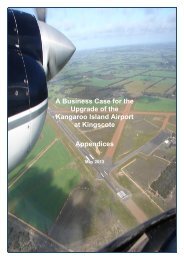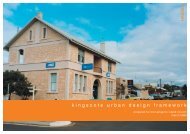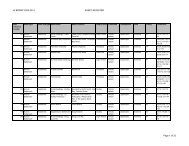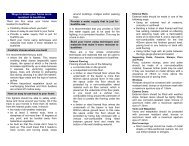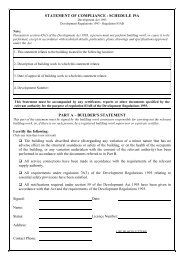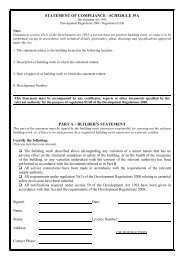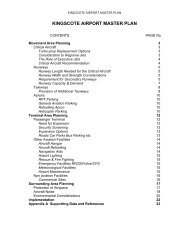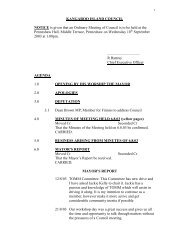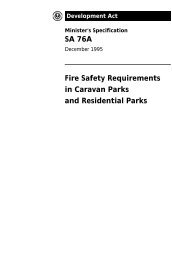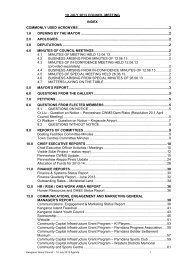Kingscote Streets Upgrades - Kangaroo Island Council
Kingscote Streets Upgrades - Kangaroo Island Council
Kingscote Streets Upgrades - Kangaroo Island Council
Create successful ePaper yourself
Turn your PDF publications into a flip-book with our unique Google optimized e-Paper software.
of 1.0 m to form a key for the fill. The minimum depth for a bench shall be the minimum layer<br />
thickness.<br />
3.3.8.6 Filling Adjacent to Structures<br />
The Contractor shall use equipment and construction techniques to protect adjacent structures from<br />
damage due to filling operations.<br />
Filling is not to be carried out against new concrete structures until fourteen days after placing the<br />
concrete or until such time as may be approved by the Superintendent.<br />
3.3.9 Backfilling of Trenches<br />
3.3.9.1 General<br />
Backfilling of trenches shall be carried out after the pipes, culverts, cables or conduits have been<br />
installed and surrounded as particularly specified.<br />
No backfilling material shall be placed until the Superintendent has approved the work to be covered<br />
and the material to be used for backfilling.<br />
3.3.9.2 Road Reserves<br />
Where a trench is located under an existing or proposed road pavement or where the nearest side of<br />
the trench is within 2.0 m of an existing or proposed road pavement, the trench above the surround<br />
material shall be backfilled using backfilling sand.<br />
Sand shall be placed in layers not exceeding 250 mm uncompacted thickness and each layer shall<br />
be compacted and tested in accordance with this specification. The sand backfill material shall be<br />
placed and compacted to the formation level of the pavement construction or the pavement<br />
restoration works specified.<br />
3.3.9.3 Other Locations<br />
Where the trench is located in a drainage easement, a reserve, a road reserve (but not closer than<br />
2.0 m from an existing or proposed road pavement), the trench above the surround material shall be<br />
backfilled using unclassified fill material which shall be placed in layers not exceeding 250 mm<br />
uncompacted thickness and each layer shall be compacted and tested in accordance with this<br />
specification.<br />
The backfill shall be placed and compacted to the formation level of any specified restoration works<br />
or to the natural surface levels adjacent to the trench, whichever is appropriate.<br />
3.3.10 Filling Behind Kerbs and Gutters<br />
On completion of the construction of the concrete kerbs and gutters, the area behind the kerb shall<br />
be filled with unclassified fill to 150 mm below the top of the kerb and compacted to the density<br />
specified herein.<br />
After construction of the footpath (if any) the area shall be surfaced with 150 mm thickness of lightly<br />
compacted topsoil, garden loam or dolomite as shown on the drawings.<br />
3.4 Quality Requirements – Earthworks<br />
3.4.1 General<br />
The Contractor shall arrange for testing of the compaction of bulk earthworks filling and trench<br />
backfilling. The testing shall be carried out by a NATA accredited laboratory, in accordance with<br />
AS 1289 – Methods of Testing Soils for Engineering Purposes, and all costs will be borne by the<br />
Contractor.<br />
Copies of the test results shall be made available to the Superintendent for his approval prior to the<br />
commencement of construction of any subsequent layer. The Contractor shall programme the<br />
works accordingly and no claims for delays will be considered due to delays in the availability of<br />
such test results to the Superintendent.<br />
Ref No. 20120236SA1 <strong>Kingscote</strong> <strong>Streets</strong> <strong>Upgrades</strong> Technical Specification 9



